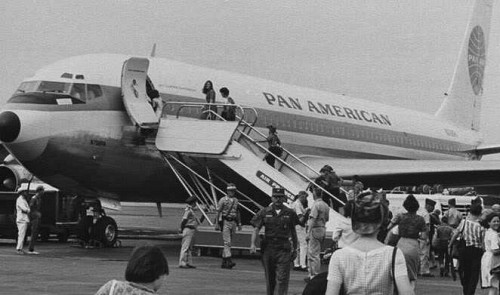By the late 1950s, Tan Son Nhat Airport had become an integral component in the U.S. plan to fly military, economic, and political advisors into South Vietnam.
The original French-built runway began to crumble under the strain of increasingly frequent use by heavy aircraft, leading to the construction of a new, longer runway.
The first jet runway
One day in September 1962, a monumental event was held in Saigon: President Ngo Dinh Diem of South Vietnam oversaw the inauguration of an A-class runway at Tan Son Nhat Airport, the longest in Southeast Asia at the time.
In his remarks, Diem spoke of the urgent need to upgrade Tan Son Nhat into a first-class international airport ready to receive the largest and most modern jet airliners available.
Diem’s administration had begun to upgrade Tan Son Nhat just three years earlier when the southern airport’s single runway was first becoming overloaded.
At the time, the existing 2.4-kilometer red soil runway was only able to accommodate propeller-driven airliners weighing less than 65 metric tons, a requisite quickly becoming more and more outdated as breakthroughs within the global aviation industry led to the introduction of much larger and faster jet aircraft.
The upgrade project, a cooperative effort between U.S. contractor E.V. Lane Corporation and Vietnam’s Necideco, began in 1959 with the involvement of 30 U.S. specialists, 300 Vietnamese specialists and 900 workers.
As part of the project, concrete runway 07R/25L measuring over 3,000 meters long and 45.72 meters wide was built along with several taxiways and a 480 x 99m hangar.
By 1960, the airport’s total area had been expanded to 1,500 hectares and boasted a newly paved 30-centimeter thick concrete floor capable of supporting commercial jet airliners weighing up to 135 metric tons.
State-of-the-art systems designed to assist aircraft with landing in even the most bizarre weather conditions were also installed during the upgrade.
The upgrade cost a total of US$4,854,261 (equivalent to over $40 million today after inflation was considered), of which around $1 million was contributed by the South Vietnam government and the rest was funded by the U.S.
After the project was completed in September 1962, Tan Son Nhat gained the ability to accept flights well beyond its previous capacity of 40,000 flights per year, contributing to a drastic increase in the number of American citizens visiting Saigon for travel, work, and business – a trend which led to the establishment of a joint committee for airlift coordination between South Vietnam and the U.S. in 1963.
The committee was headquartered at Tan Son Nhat Airport and comprised of representatives from South Vietnam’s Air Force Command and Civil Aviation Bureau, as well as advisors from the U.S. Air Force and civil aviation authority.
The committee was responsible for air traffic control, communication, ground support, and airlift missions at the airport.
Southeast Asia’s latest twin runways
Though the upgrades were integral to the airport’s development, the first A-class runway at Tan Son Nhat soon proved incapable of handling the skyrocketing number of civil and military flights coming to and going from the airport at the height of the American war in Vietnam between 1962 and 1967.
During this period, the runway was used for at least 2,000 flights on a daily basis, ten percent of which were military jets, leading to its fast degradation.
To cope with the situation, the runway underwent a complete $500,000 renovation while construction on a second runway commenced in 1966.
By May 1967, Tan Son Nhat had become the second airport in the country, after Da Nang Airport, to boast twin A-class runways able to support jet airliners.
At the time, no other country in Southeast Asia could boast an airport with such impressive runways, making Tan Son Nhat the busiest airport in the region, capable of landing and launching even the most modern supersonic jets.
On July 3, 1971, 400 passengers landed safely at Tan Son Nhat on a Boeing 747, at that time the largest commercial airliner ever built, operated by American airline PANAM.
A month later, on August 14, 1971, a giant Lookheed C-54 Galaxy military transport aircraft, designed to carry a maximum load of 350 metric tons, landed for the first time at Tan Son Nhat.

























































